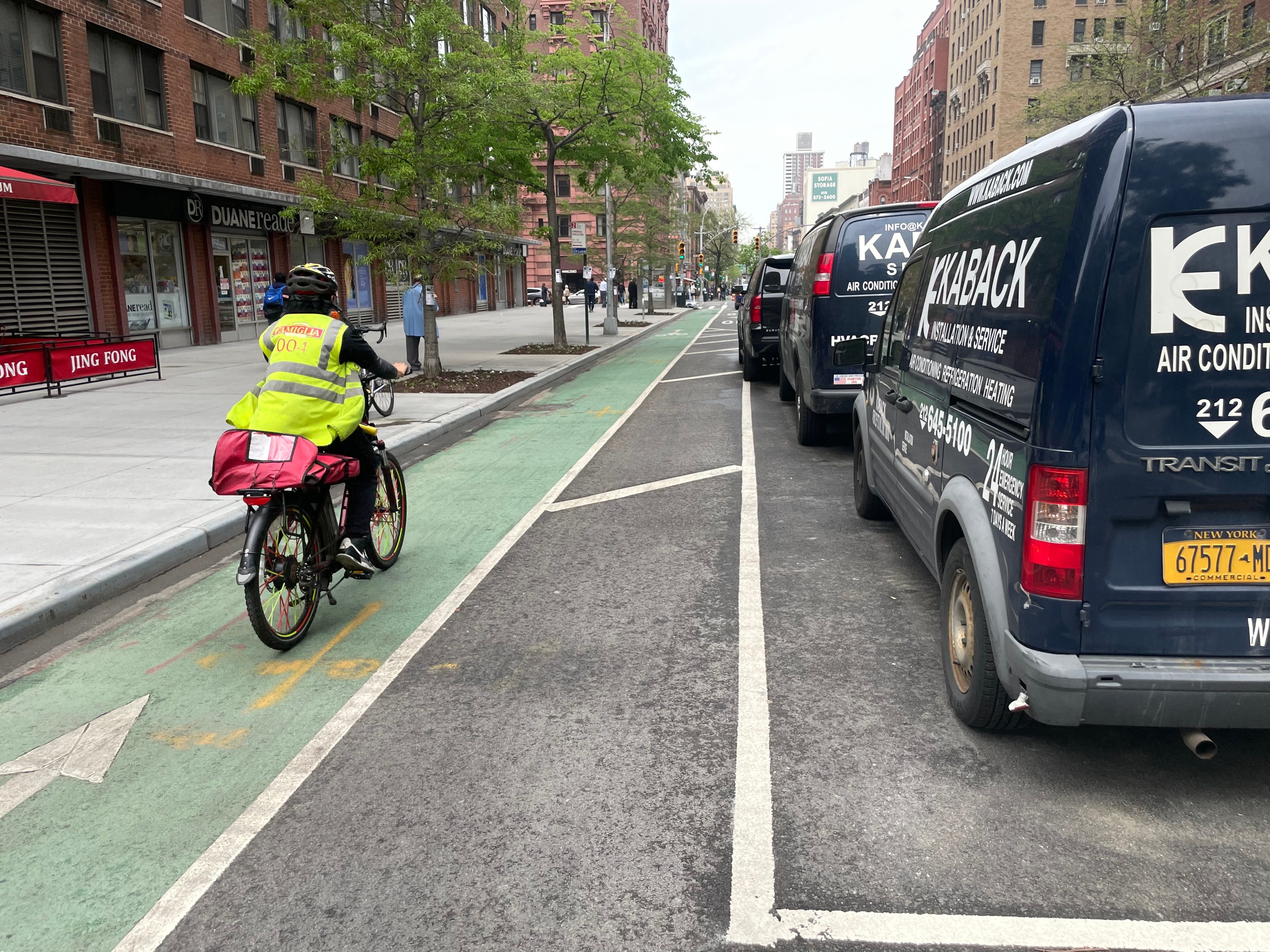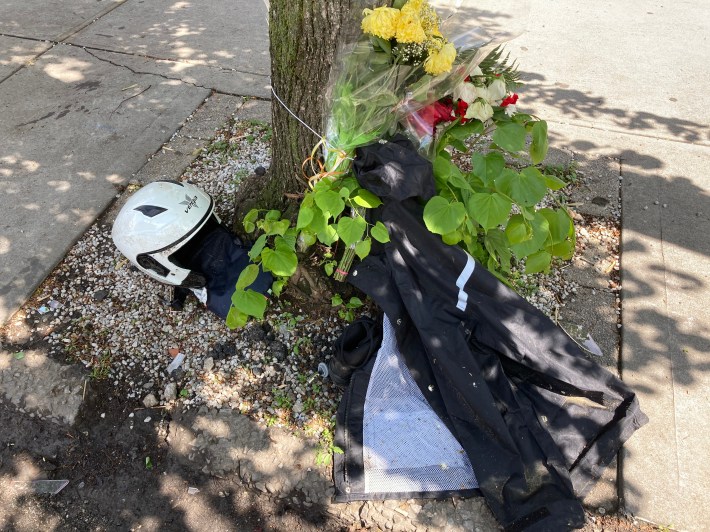DoorDash Joins 15-Minute-or-Less Grocery Delivery Biz, Risking Workers’ Lives, Advocates Say
12:01 AM EST on December 7, 2021

An e-bike rider in the Amsterdam Avenue bike lane near W. 78th Street. File photo: Lisa Orman

A major food delivery app is now promising grocery deliveries to your doorstep in under 15 minutes — treacherous New York City streets be damned — joining the growing market of ultra-fast delivery from start-ups such as Gorillas, JOKR, and Fridge No More.
San Francisco-based DoorDash announced on Monday it would launch DashCorps — a new 10- to 15-minute delivery service featuring bike couriers delivering goods from local grocery hubs, so-called DashMarts, within a two-mile radius. DashCorps will launch only in the Chelsea neighborhood of Manhattan to start, but will expand to other neighborhoods and boroughs, and eventually partner with bodegas, too, according to DoorDash.
The company also promised that worker “safety” is a “critical component” of its business, but advocates who have long fought for better working conditions for the city’s estimated 65,000+ deliveristas say DoorDash's business models requires those workers to operate recklessly to make the tech giant its money.
“For months we’ve been following these fast deliveries, the new ones coming to New York, like Gorilla, and Fridge No More, we saw that they’re not safe in the way they train workers — don’t follow the green lights, go between cars, going crazy to drop off a banana,” said Gustavo Ajche, a delivery worker and member of Los Deliveristas Unidos.
So far this year, Ajche said, 12 delivery workers have died on the streets of New York City, including 24-year-old Borkot Ullah, Federico Zaput Palas, and 37-year-old Xing Long Lin — and scores more have been injured.
“The streets are not safe, and the apps are pushing to go faster, faster, faster,” Ajche added. “It risks the life of deliveristas.”
Actually, considering the number of times a week I get brushed back by bike delivery running a light / on the sidewalk / wrong way in a one way bike lane... let's all agree 30 minutes is fine. JFC 🙄 https://t.co/Za9Pe7q7wI
— Whatcha Lookinatt 🖕🏾 (@FsckOffFash) December 7, 2021
DoorDash says that unlike its gig workers delivering restaurant grub for low pay and the possibility of a tip, the couriers in the new DashCorps will be paid $15 an hour (the city’s minimum wage). They will also have access to a new in-app safety toolkit called SafeDash, which launched last month, but appears merely to provide workers with another way to call 911.
A rep for DoorDash told Streetsblog that all DashCorps couriers — again, unlike the army of independent contractors called Dashers — will be provided with an e-bike capped at 20 miles per hour, and will receive a vest and helmet. The rep added that DoorDash will employ about 60 couriers at each of its DashCorps locations — part of an increasingly competitive industry of sub-15 minute grocery deliveries (so competitive that missing the 15-minute time limit earns a hard-working deliverista a public shaming by the New York Times).
The company said it is partnering with the cycling advocacy group Bike New York to provide training and equipment.
Bike New York President and CEO Ken Podziba said his group is piloting an educational curriculum with DoorDash that will provide couriers with basic riding skills, including teaching the rules of the road, like yielding to pedestrians.
"Bike New York’s mission is to empower bike riders and increase bike ridership, and a key part of that work is ensuring that bike riders feel safe and have the resources they need," Podziba said in a statement. "DoorDash shares that commitment, and we commend them for prioritizing rider safety and embarking on this new offering responsibly. By working together on safety policies, building safety culture, and education and training, we can help ensure that riders have the skills they need to confidently navigate New York City streets on and off the job."
A sign-up form to become a member of DashCorps, which was provided to Streetsblog, says that couriers must first participate in a two-hour training. It also says that those who work more than 30 hours a week will have access to health benefits (though it is unclear how many of these workers will reach that threshold); and couriers who become a part of the DashCorps can no longer deliver as a regular Dasher, but could work for other apps. Unlike the current network of independent contractors for DoorDash, the bike couriers hired as part of its first DashCorps program will be employees of the company.
Like other delivery app companies, DoorDash has been under fire for business practices that virtually require deliveristas to break traffic rules or risk their own safety to make a decent living. And like the others, DoorDash baits its workers with more money and tips the faster they go. Some companies punish workers who don't take long deliveries, which are particularly unprofitable.
“It's, 'If you go faster, I’m gonna pay you more,'” said Hildalyn Colón Hernández, director of Policy and Strategic Partnerships of Los Deliveristas/Workers Justice Project. “This is not DoorDash being a good employer.”
The city is trying to rein in the worst excesses of the tech delivery subculture. In September, the City Council passed — without the support of DoorDash — an historic package of bills aimed at improving delivery workers' conditions and regulating the massive multi-million-dollar industry, including requiring restaurants to allow workers to use the bathroom, setting a minimum wage, and giving workers the option to refuse some trips.

DoorDash has recently been trying to connect its brand to the work of safety advocates. In addition to the partnership with Bike New York, Door Dash sponsored Transportation Alternatives' Vision Zero Cities conference back in October, but advocates said they don't see DoorDash doing the work on the ground.
The demand for ultra-fast grocery delivery could not only lead to a rise in crashes, but also contribute to a misplaced fear of e-bikes, according to Colón Hernández — frustration that she says is only compounded by the NYPD still not knowing the very laws they're supposed to uphold, or even how to tell the difference between a legal e-bike and an illegal moped.
"[Delivery companies] demand that delivery workers go so fast [and] people take it out on the easy target, who they see everyday, who they see in front of them. Make companies accountable," Colón Hernández said. "NYPD still doest know what an e-bike, moped is."
Anti-bike politicians have jumped into the breach, with state Sen. Simcha Felder (R-Brooklyn) claiming that e-bike riders have caused a “bloody battle for pedestrians," but saying nothing of the demanding customers who order food and expect it to arrive in minutes, still hot. And Streetsblog reported in August that the city's own data show that e-bikes are still far less dangerous than multi-ton cars and trucks.
From Jan. 1 through June 25, 2021, there were 3,101 crashes that led to the injury of a pedestrian. Of those crashes, 2,870, or 93 percent, were caused by the driver of a truck, van, SUV, car or other four-plus-wheeled motor vehicle. Only 132 crashes — or 4 percent — were caused by the users of e-bikes, e-scooters, mopeds or motorscooters (or any of the other words that cops use to classify two-wheeled motored vehicles).
Over the same period in 2019*, there were 3,281 crashes that led to the injury of a pedestrian. Of those crashes, 3,098, or 94 percent, were caused by the driver of a truck, van, SUV, car or other four-plus-wheeled motor vehicle. Only 28 crashes, or less than 1 percent, were caused by a micromobility user. And crashes involving cars are typically far more violent than those involving cyclists, even those on mopeds.
Those numbers followed Streetsblog’s reporting from 2019, which revealed that e-bike riders caused just 32 — or .05 percent — of all the 61,939 injuries to all road users in 2018.
But the city's own stats have not been enough to stop myopic reactionaries like Felder and an Upper West Side community board from launching a backlash on a mode of transportation that is far cleaner and safer than cars, but nonetheless intimidate pedestrians because mopeds and faster bikes are not given protected space. The current backlash began this summer after actor Lisa Banes was killed by the rider of an illegal moped. Another Upper West Side pedestrian was killed by an e-bike rider after he walked into the middle of the road, mid-block.
* Streetsblog uses 2019 data instead of 2020 data because of dramatically aberrant traffic patterns during the pandemic year.
Julianne Cuba joined Streetsblog in February, 2019, after three years covering local news and politics at The Brooklyn Paper. There, she also covered the notoriously reckless private carting industry and hit-and-runs. A 2015 graduate of Stony Brook University’s School of Journalism Master’s Program, she lives in Brooklyn. Julianne is on Twitter at @julcuba. Email Julianne at julianne@streetsblog.org
Stay in touch
Sign up for our free newsletter
More from Streetsblog New York City
Thursday’s Headlines: Speed-Limiting Tech Edition
State Sen. Andrew Gounardes continues his push to force reckless drivers to install speed limiters in their cars. Plus more news.
DOT Official: All Our Free Parking Justifies Keeping Curb Space for EVs
If only someone could do something about the parking!
New York City to Install 500 Secure Bike Parking Hubs In The Next Five Years: Sources
Your bike may finally get a roof over its head.
Adams Backs Lower Speed Limits, Calls Crashes ‘Accidents’
The mayor wants New York City drivers to "slow down," but it's not clear yet how many streets will get lower speed limits.
Wednesday’s Headlines: Trump Posts About Congestion Pricing Edition
Donald Trump comments on congestion pricing — no surprise, he's against it. Plus more news.




